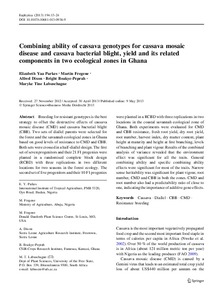| dc.contributor.author | Parkes, E. |
| dc.contributor.author | Fregene, M. |
| dc.contributor.author | Dixon, A. |
| dc.contributor.author | Boakye-Peprah, B. |
| dc.contributor.author | Labuschagne, M.T. |
| dc.date.accessioned | 2019-12-04T11:04:24Z |
| dc.date.available | 2019-12-04T11:04:24Z |
| dc.date.issued | 2013-05 |
| dc.identifier.citation | Parkes, E., Fregene, M., Dixon, A., Boakye-Peprah, B. & Labuschagne, M. (2013). Combining ability of cassava genotypes for cassava mosaic disease and cassava bacterial blight, yield and its related components in two ecological zones in Ghana. Euphytica, 194(1), 13-24. |
| dc.identifier.issn | 0014-2336 |
| dc.identifier.uri | https://hdl.handle.net/20.500.12478/1418 |
| dc.description.abstract | Breeding for resistant genotypes is the best strategy to offset the destructive effects of cassava mosaic disease (CMD) and cassava bacterial blight (CBB). Two sets of diallel parents were selected for the forest and the savannah ecological zones in Ghana based on good levels of resistance to CMD and CBB. Both sets were crossed in a half-diallel design. The first set of seven progenitors and their 21 F1 progenies were planted in a randomised complete block design (RCBD) with three replications in two different locations for two seasons in the forest ecology. The second set of five progenitors and their 10 F1 progenies were planted in a RCBD with three replications in two locations in the coastal savannah ecological zone of Ghana. Both experiments were evaluated for CMD and CBB resistance, fresh root yield, dry root yield, root number, harvest index, dry matter content, plant height at maturity and height at first branching, levels of branching and plant vigour. Results of the combined analysis of variance revealed that the environment effect was significant for all the traits. General combining ability and specific combining ability effects were significant for most of the traits. Narrow sense heritability was significant for plant vigour, root number, CMD and CBB in both the zones. CMD and root number also had a predictability ratio of close to one, indicating the importance of additive gene effects |
| dc.format.extent | 13-24 |
| dc.language.iso | en |
| dc.subject | Cassava |
| dc.subject | Diallel |
| dc.subject | Resistance |
| dc.subject | Breeding |
| dc.title | Combining ability of cassava genotypes for cassava mosaic disease and cassava bacterial blight, yield and its related components in two ecological zones in Ghana |
| dc.type | Journal Article |
| dc.description.version | Peer Review |
| cg.contributor.crp | Roots, Tubers and Bananas |
| cg.contributor.affiliation | International Institute of Tropical Agriculture |
| cg.contributor.affiliation | Ministry of Agriculture, Nigeria |
| cg.contributor.affiliation | Sierra Leone Agricultural Research Institute |
| cg.contributor.affiliation | Commonwealth Scientific and Industrial Research Organisation, Australia |
| cg.contributor.affiliation | University of the Free State |
| cg.coverage.region | Africa |
| cg.coverage.region | West Africa |
| cg.coverage.country | Ghana |
| cg.isijournal | ISI Journal |
| cg.authorship.types | CGIAR and developing country institute |
| cg.iitasubject | Cassava |
| cg.iitasubject | Genetic Improvement |
| cg.journal | Euphytica |
| cg.howpublished | Formally Published |
| cg.accessibilitystatus | Limited Access |
| local.dspaceid | 79559 |
| cg.identifier.doi | https://dx.doi.org/10.1007/s10681-013-0936-9 |

